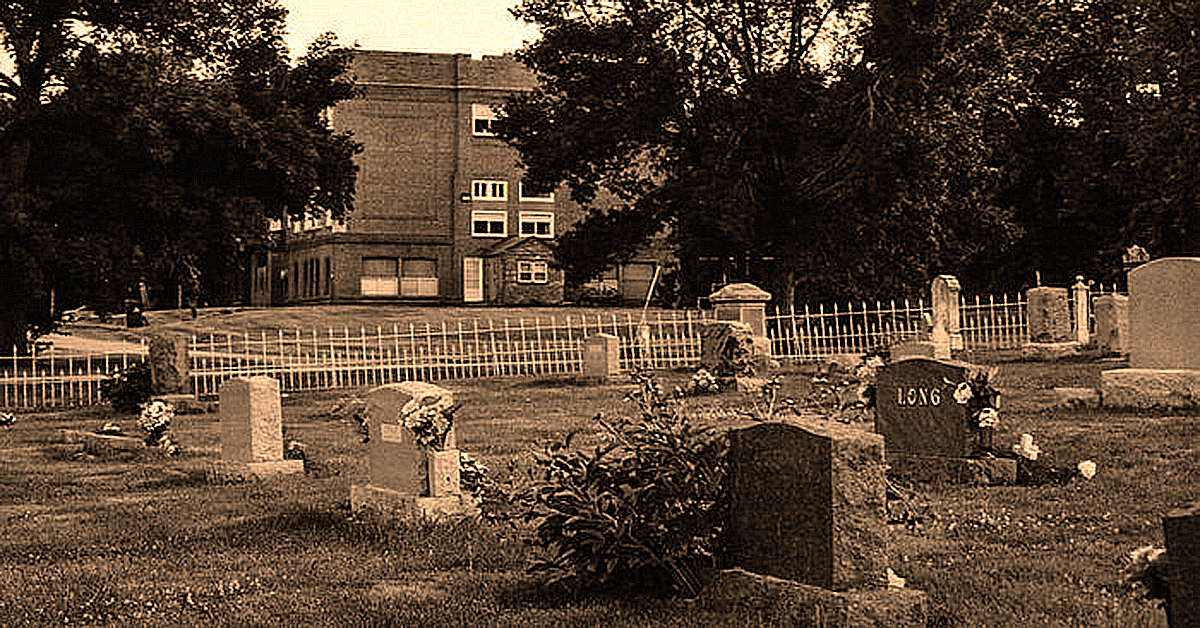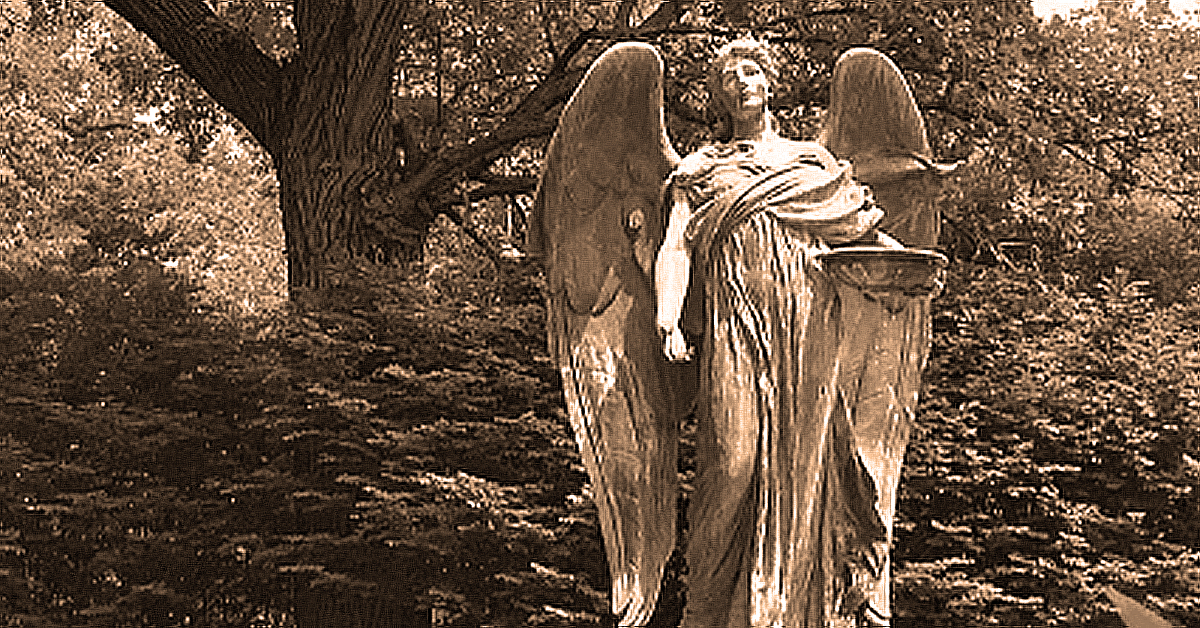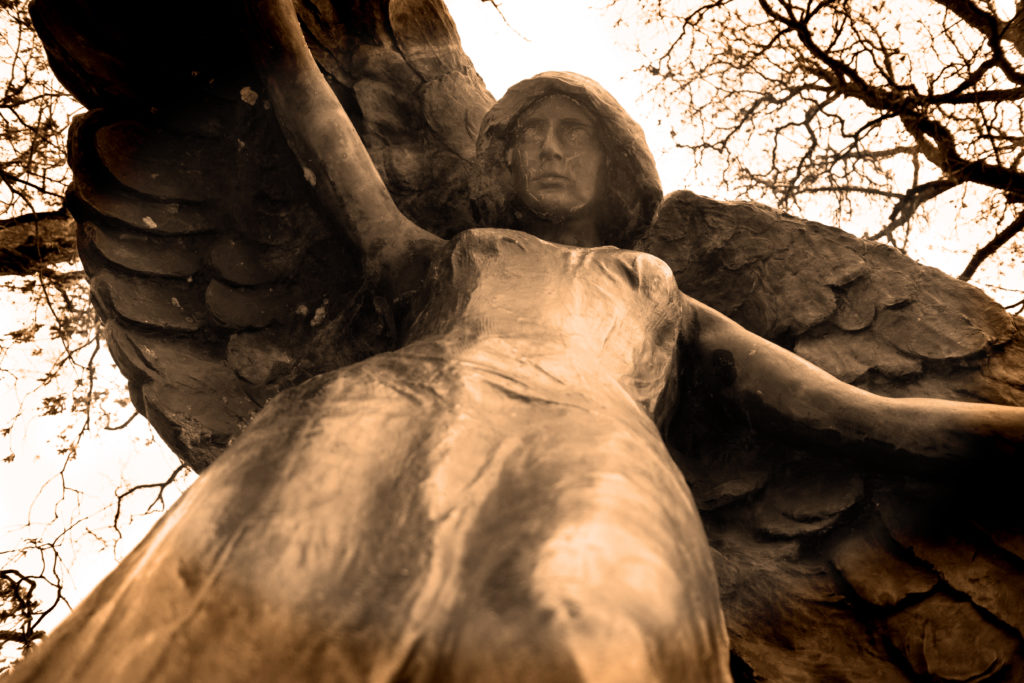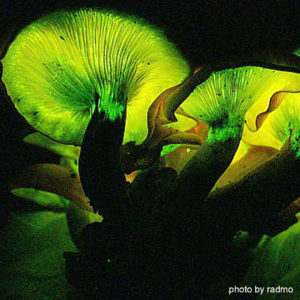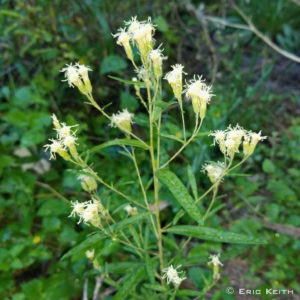
by Jeanie Hau | Oct 10, 2023
Our Lincoln Highway Heritage Byway coordinator’s top 11 choices for haunts along or near the Lincoln Highway in Iowa:
#11) Marsh Rainbow Arch Bridge is just south of Lake City (14 miles north of the Lincoln Highway at Glidden). This haunted bridge has a ghost after my own heart. It is said that if you visit this bridge at night and leave a candy bar (particularly chocolate) on the road, that the chocolate will be gone the next day but the wrapper will still be completely intact and unopened. Once I am gone, please leave Reese’s Peanut butter cups, and I will come visit!
#10) The Boone News Republican Building, Downtown Boone
Workers at night would hear footsteps running on stairs or hear their name called when the place was empty. The historic building was to be renovated and made into apartments in the fall of 2023.
#9) Riverside Cemetery, Marshalltown
There is a concrete chair in the cemetery that looks like wood. If you dare to sit upon it, you will have bad luck or even die within the year.
#8) Coe College, Cedar Rapids
Getting a good night’s sleep at this college has been challenging for some due to a ghost’s midnight antics. Helen, who was a victim of the influenza outbreak of 1918, is said to haunt the campus. She likes to come out at night and play piano in the parlor or take the covers off of students while they are sleeping.
#7) Granger House, Marion
It has been said that the white figure of a young woman can be seen sitting in front of a window at midnight.
wdd#6) Periwinkle Place Manor, Chelsea
The 3-story, 9-bedroom inn occupies a former funeral home that operated from 1892-2003. Now, the manor is a bed and breakfast that hosts events such as murder mystery dinners, weddings, concerts, wine tasting, and of course ghost hunters.
#5) Farrar Elementary Schoolhouse, Maxwell
(approximately 17 miles south of Lincoln Highway) Jim and Nancy Oliver purchased the abandoned schoolhouse in 2006, in hopes of making it their home. While working on the soon-to-be home, Nancy, after becoming unbalanced on the stairs, felt someone helping her. She assumed it was her husband. She turned only to see a small boy standing on the step, only to disappear a full two seconds later. Visited by dozens of paranormal groups and individuals.
#3) Farm House Museum at Iowa State University. The Farm House is believed to be haunted by two women, Edith Curtiss and Esther Wilson. It is thought that Edith Curtiss will open closed curtains on the second floor every night while the house is locked up. Every morning the curtains will be open even if they were held by safety pins. Esther will turn flatware to a 45-degree angle; the curators have since sewn down the silverware to the tablecloths so that they cannot be moved. Many other locations on the campus are also haunted, including Shattuck Theater, C.Y. Stephens Auditorium, the Gold Star Hall, and several dorm buildings.
#2) Squirrel Cage Jail, Council Bluffs
This one-of-a-kind, three-story jail was in use from 1885-1969. One of eighteen revolving jails in the US, the floors were divided into dark and damp pie-shaped cells that were extremely small. The jail is said to be haunted by former jailers, the original construction supervisor, a woman, and even a little girl and two ghost cats.
#1) The Black Angel Monument, Oakland Cemetery, Iowa City
Angels in cemeteries are almost always positioned looking upward as if toward heaven; however, the angel monument at Oakland Cemetery in Iowa City was created with the face looking downward and the wings poised over the graves below. Since the eight-and-a-half-foot-tall burial monument was erected over 85 years ago, it has been the subject of many stories and legends. A once golden or perhaps ivory color, the monument is now completely black and has gained the reputation that kissing, touching, defiling, or even staring at the angel too long will bring about a terrible accident, disease, miscarriage, or death. Even so, the angel attracts thrill seekers who can’t help but tempt fate and the Angel of Death.

by Jessica Butters | Oct 3, 2023
As the rays of summer creep towards the embers of autumn, now is a great time to go on a long walk to breathe in the changing of the seasons. While most people will be putting up lights and hoarding candy for Halloween, you can hit the trails to see some of the most interesting and spooky beings found naturally, right here in Iowa! Here we compile all things October to give you the best time to hike, where to find fairy fires and ghostly plants, and facts about curious birds this autumn.
Fantastic Foliage and When to Find It
To enjoy the best fall leaf display, the best practice is to go for a walk each day. If this is impossible, or you love planning, check the Iowa Department of Natural Resources’ Fall Color Report online (or sign up for email updates on their report page).
Toadstools at Twilight
Did you know that Iowa is home to glowing mushrooms?! The Jack-O’-Lantern mushroom (Omphalotus illudens) is pumpkin-orange in daylight, and lights up at night! Its light, also called fox fire or fairy fire, is created through bioluminescence. Remember that mushrooms are merely the reproductive parts of fungi. The majority of the fungus is actually underground. To find Jack-O’-Lantern mushrooms, search forests during the day for orange, classic-shaped mushrooms at the base of trees, and then return to areas where you found them on a dark night (with a friend for safety!). Give your eyes time to adjust after you put your lights out – the glow comes from the gills (on the underside of the mushroom) and will be faint. Please don’t harvest the mushrooms – they are poisonous.
Glowing Jack-O’-Lanterns on a dark night
Peculiar Plants
Some native plants you can see now in central Iowa, with quintessential Halloween-like names, include “false boneset,” “doll’s eyes,” and “ghost plant.” False boneset (Brickellia eupatorioides) is named for the fact that its bone-colored flowers and plant structure resemble “true” boneset flowers. However, it is in a different genus of plants. False boneset is an important late-blooming flower for pollinators, and has a fluffy white display after flowering. It also does not spread aggressively, making it a great addition to pollinator gardens.
“Doll’s eyes” (white baneberry, Actaea pachypoda), is native to eastern Iowa. This small shrub produces white berries with a large black spot in the center, looking eerily like doll eyes. Adding to this eeriness, the “eyes” are poisonous to mammals, including humans. The closely related red baneberry (Actaea rubra) is native to central Iowa and sometimes produces white berries as well. Berries of both plants are eaten by birds, who don’t digest the poisonous seeds. You can find both plants in forested, shady areas with deep leaf layers.
Doll’s Eyes keep watch in the forest
Ghost plants (Monotropa uniflora) are the star of our peculiar plant category. This plant is truly ghostly white, containing no chlorophyll (read: no green color) for photosynthesis. So how does it get its nutrients? It steals it from fungi! The fungi (specifically, mycorrhizae) share nutrients with neighboring tree roots, and the ghost plant taps into this nutrition-sharing system to help itself. October is near the end of this plant’s flowering season, but the best chances of finding it are in undisturbed forest areas with a deep organic layer.
Pale Ghost Plants on the forest floor
Alluring Animals
The harbinger of spooky season is the caw of the crow. Though present year-round, they are more appreciated during the twilight of the year. Seemingly ominous with their dark feathers and willingness to scavenge, these birds are in fact quite endearing. Not only are they intelligent enough to create and use tools to get food, but their offspring, once grown, normally return the next year to help tend to their younger siblings! Maybe groups of crows should be called “families” rather than “murders.” Lastly, how can you tell the difference between a crow and a raven? Firstly, ravens aren’t really found in Iowa – the closest area of their range is in northern Minnesota and Wisconsin. Secondly, the classic “caw” sound is distinctly crow, while ravens croak instead.
A crow perches in a young tree
October is a lovely time of year, providing unparalleled weather and colors to enjoy Iowa’s outdoors. It is easy to agree with Aldo Leopold’s musing, that “…other months were constituted mainly as a fitting interlude between Octobers.” May you soak up this golden month of the year, and all it has to offer!
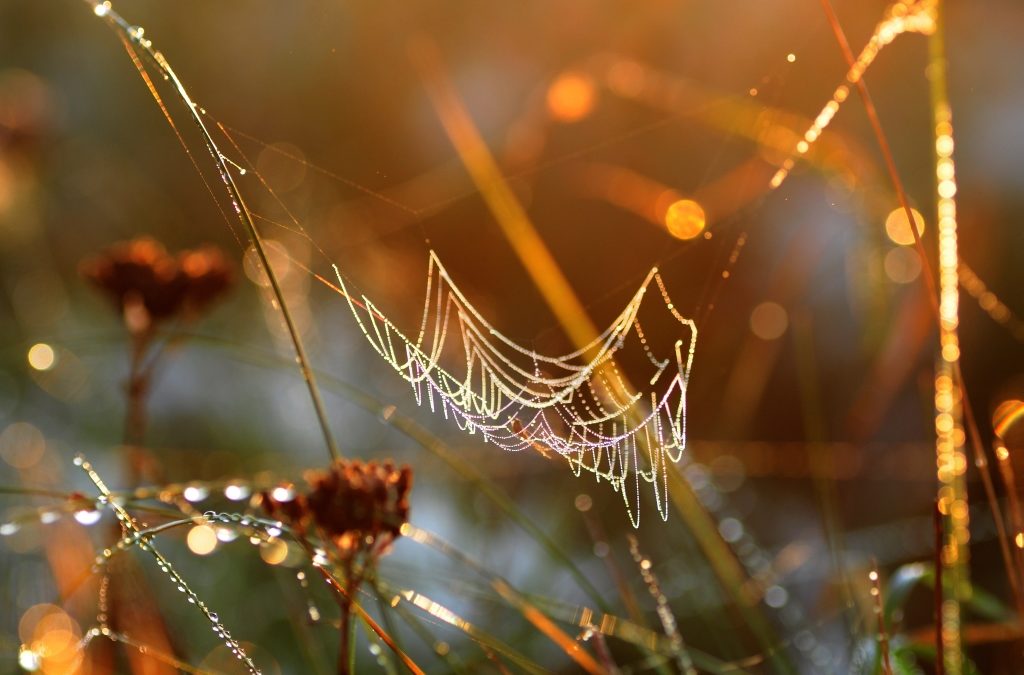
by Jessica Butters | Oct 3, 2022
These Halloween icons are in reality quite charming, and provide us with valuable services!
The crisp October air brings the excitement of changing leaves and a changing season. While making yards and gardens cozy for wildlife braving the winter is a common discussion this time of year, we are focusing on what kinds of important wildlife you may notice this month! With Halloween around the corner, now is the perfect time to better understand some of the spooky (or maybe not-so-spooky-after-all) animals that you may see in autumn!
Owls
Soon leaves will fall to the ground, making it easier to spot this inquisitive bird of prey. The barred owl in particular hoots in a pattern that sounds like they’re asking “Who cooks for you? Who cooks for you all?”. I think we all wish the answer to that question was “someone else”. While this call at night may sound spooky, barred owls have some endearing qualities. This species mates for life, and lets its young stay near home longer than other species – up to six months! You can look for barred owls in Ames in mature tree stands near a water source. To help all owls, try to stop putting out rodent poison; owls eat rodents, and can consequently become sick from the poison. Healthy owls in your area may mean natural rodent control for you! Additionally, some owls utilize nesting boxes; you can contact Wild Birds Unlimited here in Ames to learn more!
Bats
Could we truly celebrate Halloween properly this month without bats? From décor to Dracula, this fuzzy animal’s image will be seen everywhere this month. However, the animals themselves will be seen less and less. Bats remaining in Iowa during winter are now looking for cozy spots for hibernation, especially as the amount of insects declines this month. Bats are great at gobbling down mosquitos and other pesky insects (the bat pictured here can eat 600 insects in an hour!), and their babies are called “pups”! These animals are much more helpful and cute than they are spooky.
To help bats, consider building a bat box for fun! If a bat gets in your home, remember that they will not fly into you; they are expert navigators and will avoid you while they try to fly up and away. Calmly open a door or window for it to fly back outside and stand still at a distance until it leaves. If it can’t find the exit, call the Iowa Wildlife Center (515-233-1379) or other wildlife societies to have experts remove the bat in a humane way.
Spiders
Many people try their best to be open-minded towards insects, but most find spiders hard to appreciate (spiders are not technically “insects” – they’re “arachnids”). During late summer and early fall, you may see spiders more often, but don’t panic. They are not “coming in” to escape cool temperatures. Most spiders you see indoors are specifically adapted to survive indoors, where there is little food and water. Outdoor spiders are not well-adapted to live inside our homes, and are not trying to sneak in; their food is outside, and that’s where they’ll stay! If they accidentally wander in, they will not survive more than a few days, and won’t reproduce. What you are probably seeing are indoor spiders that have been inside this whole time, not bothering you at all.
But why are you seeing indoor spiders more often than usual? Because they are in love! This time of year is the mating season for many spiders, and instead of stealthy squatters, you’re seeing love-sick troubadours! Besides embarking on their quest to find love, spiders are also fantastic household helpers, eating any insects they may find along their way. I tend to leave spiders alone if they are along baseboards and in corners. If one particularly bothers me, I use a paper and cup to catch it and place it outside.
This time of year is beautiful in Iowa, and it’s the perfect time to find ways to appreciate the beauty of living things that continue to serve our needs, despite our fear of them. Happy Fall!
Household Tip: To truly understand any animal/insect you see in or around your house, look up information from science-based sources, such as university extension websites, rather than pest-control companies. Pest-control websites are likely to present alarming information, possibly to encourage use of their services. A majority of the time, whatever you are seeing is not only common, but harmless as well.
Links in Text:
Leave The Leaves! Xerces Society blogpost, by Justin Wheeler:
https://xerces.org/blog/leave-the-leaves
Wild Birds Unlimited, Ames (515-956-3145) Website:
https://ames.wbu.com/?utm_source=google&utm_medium=local&utm_campaign=localmaps&utm_content=279
Woodworking for Wildlife, Iowa State University, link to PDF file on how to build a bat box:
https://naturalresources.extension.iastate.edu/wildlife/woodworking-wildlife
by Janice Gammon | Oct 14, 2015
The calendar says FALL, but the weather has been summer-like for the most part. Even though, Mother Nature knows when to change the outdoor color scheme from a variety of greens to collections of golds, reds, and oranges. As we travel the Lincoln Highway Heritage Byway, the green fields of corn have all turned gold and farmers are busy in the fields. Harvest time. I love harvest time! Just watch for slow moving vehicles and give the large equipment room to maneuver on the road.
The kids might be back in school, but on the weekends there are many things to do. Several people have posted on Facebook that they are taking the Boone and Scenic Valley Railroad to see the beautiful views of the Des Moines River Valley near Boone. This is on my list of things to do this fall.
There are many Pumpkin Patches along the route for families to visit and to ride hayrack rides out to fields to select their own jack-o-lanterns. Many orchards also have apples ripe for the picking and my apples are going towards making apple crisp- it’s my favorite dish this time of year. My favorite orchard is the Berry Patch, just outside of Nevada (where I live), but there is also Allen’s Orchard in Marion, Buffalo Ridge Apple Orchard and Gardens to the east of Cedar Rapids, Deal’s Orchard outside of Jefferson, William Orchard near Denison, and Dittmer’s Orchard and Welch’s Orchard outside of Council Bluffs. There may be more near you-just use google and get directions and hours for each.
Along with the Halloween theme are haunted houses or haunted forests. The Carroll County Arts Council/Community Theatre is hosting a Scream Forest on Saturday and Sunday, Oct 23, 24 and Oct 30, 31 from 7-10PM. Meet at Swan Lake Park at the East shelter. They advertise it as over a mile long walk of FEAR. Sounds really scary!! Find them on Facebook and learn more.
Ames holds their Haunted Forest at S 4th St. Admission is $14 for Oct 16, 17, 18 and $15 for October 23, 24, 25, 29, 30, and 31. More information at www.ameshauntedforest.com
The Periwinkle Place Manor in Chelsea holds Murder Mystery Dinners every Saturday and some Friday nights. Check out their website at www.murdermysterydinnersiniowa.com for more information.
If you enjoy scary events, just google to find more events in your area. I know we are not listing everything available.
If real paranormal activity is more your “speed” (a little Byway humor), stop by the Niland’s Corner in Colo and talk to Sandii about the group that came to record activity at that location. It is quite interesting and might put a chill up your spine!
Whatever your favorite fall activity might be, get out on the Byway and enjoy yourself! This is Iowa and all too soon we will be into another season. Enjoy the Fall while you can and I’ll see you along the Byway.








